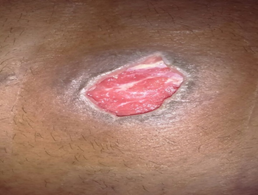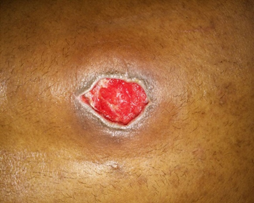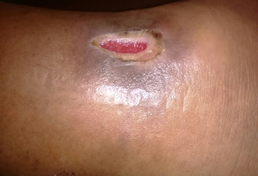ISSN 0976 - 0075
“The destruction / break / rupture / discontinuity of body tissue / part of body, is called
VRANA” A clean wound in a normal body heals earlier with a minimum scar as compared to contaminated wound.
Wound healing is mechanism where the body attempts to restore the integrity of the injured part. Several factors affects the normal process of wound healing such as the site of wound, contamination (foreign bodies/bacterial), local factors like vascular insufficiency or previous radiation, systemic factors such as malnutrition, Disease like diabetes mellitus, Immune deficiencies and medications like steroids. Acharya Sushruta mentioned 60 Upakramas for the management of Vrana and local application of kampilakadi tail Vrana Basti is one among them. The local application of Vrana Basti is one of the best substitutes for chronic wound healing & the kampilakadi tail have better shodhana & ropana effect. A case report of 34 year – old man, who presented with complaints of an open traumatic ulcer on the dorsum of the right foot associated with pain, discharge, slough, foul smell, oedema and discolouration of the skin has been presented here.
Keywords: Dushta vrana, Shodhana & Ropana, kampilakadi Tail Vranabasti.
Introduction
Man, The superior most of all species who always remain in search of one prime goal that is perfect health.Researches are carried out from Vedic era to current ageThe wound is biggest challenge to medical profession from Vedic era.The wound is healed by three way First is primary intention, Second is Secondary intention & Third is tertiary intention (delayed primary intention) .Sometimes the wound refuses or fails to heal, this type of wound is called as Non healing wound. The Wound healing process is dependent on several local and general factors [1].
In ayurved literature these Vrana are classified as Sadyo Vrana & Dushta Vrana [2]. Dushta vrana is formed due to refusal or failure of natural healing process. Acharya Sushruta explained the vrana Chikitsa in Shashti upakramas. In this upakramas local application of medicated oil is one of the most important upakramas [2]. The medicated oil is applicable with different method like Prakshalana, Pichu, Lepa, Vranabasti on Dushta Vrana. In this case study local application of kampilakadi Tail is done with Vranabasti. In Vranabasti a wall is erected around the wound with Masha pishti about 2cm height & thickness of about 0.5 cm. In a bowl medicated oil is taken & warmed on hot water bath till it become lukewarm. This lukewarm oil is poured into the well on the wound by using spoon. When this oil get cool it is taken out & warm oil is poured again. This process is done for 30 min. [3]. In this case study kampilakadi tai[4] is use as medicated oil & this kampilakadi tail have a property of Shodhana & Ropan so it is more effective in dushtasvrana.
Case Report
A 34 yrs old male patient presented with the complaints of a non- healing ulcer. Before 2 months he was accidently injured by a steel bar the wound is formed over the Right foot. He was treated with Antibiotic ointment (Povidine iodine) by a local doctor but it failed to respond. After few days wound become infected with freely flowing pus. There was no history of DM, HTN or any other major disorder. The family history was also not significant with the patient disorder.
Local Examination:-The floor was covered by slough, edges were inflamed. Wound is seen over right foot measuring about 2.5 X1.5 X 0.5 cm in dimension with purulent discharge and irregular margin. Tenderness was also present with surrounding indurations and local rise in temperature. Local lymph nodes were not involved. There is no any immunological disorder. Routine haematology and urine investigations were within normal limits.
Every morning the wound was cleaned with the freshly prepared lukewarm panchwalkal kwatha. After cleaning kampilakadi tial Vranabasti was locally applied. Dressing was done with the sterile gauze and bandage.
Results
The clinical features of dushta vrana were improved at the end of First week and the wound was healed completely at the end of 2nd week leaving only a minimal scar . With a follow up for a period of 1months, the patient has shown no signs of recurrence.
Discussion
Effects on Vrana Vedana: Pain and tenderness was completely reduced at the end of treatment. Throbbing pain which was present at the beginning was completely reduced at the end of 1st week as the purulent discharge decreased because of the shodhana properties of Taila.
Effects on Vrana: Change in colour occurred when dushta vrana got converted into shuddha, which was due to elimination of doshas out from the body. At the end of 7th day slough was completely reduced and colour of the floor becomes pinkish and healthy granulation tissue appeared.
Effects on Vrana Strava: At the end of 2nd week the purulent discharge from the wound completely stopped, this may due to the shodhan and ropan properties of Taila.
Effects on Vrana Gandha: Foul smell present at the beginning of treatment was completely reduced at the end of 1st week. The smell was present because of the pus and as the Vrana becomes shuddha it decreases.
Effects on Vrana Aakruti: On 14th day Vrana was completely healed, this may due to Vrana Shodhana property of Taila, which provide ideal environment for healing.
Conclusion
Kampilakadi tail Vranabasti is the new substitute for Dushata Vrana. It does the action of Shodhana & Ropna. It is a simple O.P.D level procedure, relatively painless, can do without anaesthesia. Vranabasti will remove only unhealthy granulation tissue, so wound size will not increase. Patient is introduced of new technique in Ayurved.
*M.S, Scholar Shalya-Tantra Department
**M.S, Professor Shalya -Tantra Department, Dr G D Pol Foundation’s YMT Ayurvedic Medical College .
References
1) Bailey and Love’s Short Practice of Surgery: Edited by Norman S.Williams, Christopher J.K.Bulstrod
and P.Ronan O’ Connell : Published by London, Hodder Education, 25th Edition-2008,
2) Sushruta; Sushruta Samhita, Ayurved tatvasandipika,edited by kaviraj Dr.Ambikadatta shastri: Published by Varanasi, Choukambha Surbharati Prakashan - 2007.
3) Pankaj B.Patil Dissertation of Rajiv Gandhi University of Health Science Benglore,Karnataka 2011
4)Charak Samhita, Shri Chakrapani-vicharit, ayurveddipikavyakhya withyashvanttikesah Vaidyamitra Prakashan-2003 , 701,Sadashiv Peth.
Fig.1. Before Treatment

Fig.2. During Treatment

Fig.3. After Treatment
